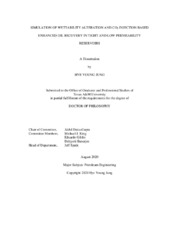| dc.description.abstract | Development of unconventional oil resources has attracted attention in recent years due to not only the rapid growth in energy demand but also emerging technologies such as multi-stage hydraulic fracturing with long horizontal wells. Some of the world’s largest oil reservoirs are characterized by low permeability and oil-wet rocks. There has been a constant need to combat this challenge. One of the key problems in tight/low permeability reservoirs, defined as resources that contain light crude oil in a less permeable formation relative to conventional resources, is that production drops rapidly. Therefore, this limited oil recovery from primary depletion in tight formation necessitates efficient solutions for enhanced recovery. In this research, we mainly focus on the application of enhanced oil recovery (EOR) methods including gas injection and surfactant injection to increase productivity for tight and low permeability reservoirs. This dissertation also presents the performance and feasibility of various EOR methods through exhaustive simulation studies.
First, our objective is to model, scale up and optimize the process using a comprehensive chemical flood simulator with wettability alteration mechanism. We start with the surfactant mechanisms in enhanced oil recovery. We then demonstrate the effectiveness of surfactant-based nanofluids for wettability alteration using a comprehensive chemical flooding simulation. Through the optimization process, the dominant parameters affecting oil recovery in tight oil reservoirs using surfactant are first identified with a synthetic case. Then, applications are extended to field scale examples that have different hydraulic fracture geometries from simple planar type to complex hydraulic fractures.
Second, we apply the Fast Marching Method (FMM)-based simulation to make the simulation of unconventional reservoirs more efficient for field applications. The FMM-based simulation enables us to perform fast computation while achieving a good approximation of results, compared to a full 3-D numerical simulation. Previous efforts to extend the FMM-based approach to multi-well cases have been improved to rigorously account for interferences between different wells with increased computational efficiency.
Finally, we perform hierarchical history matching using multi-objective Genetic Algorithm (MOGA) on a field example of carbon capture, utilization and storage in order to understand reservoir mechanism during primary depletion as well as CO2 injection period. Employing the appropriate hierarchical workflow leads to successful reservoir/fluid property calibrations while providing a reasonable match between simulation responses and observed data. | en |


